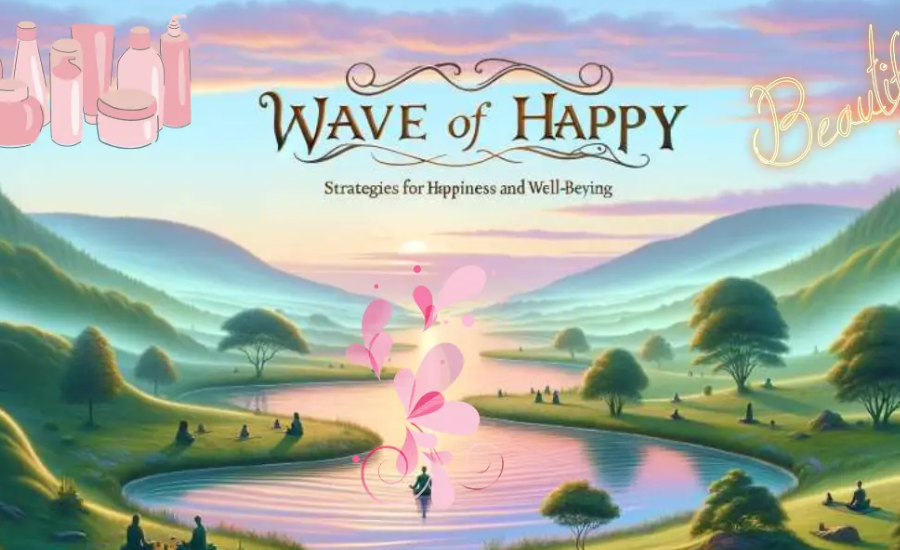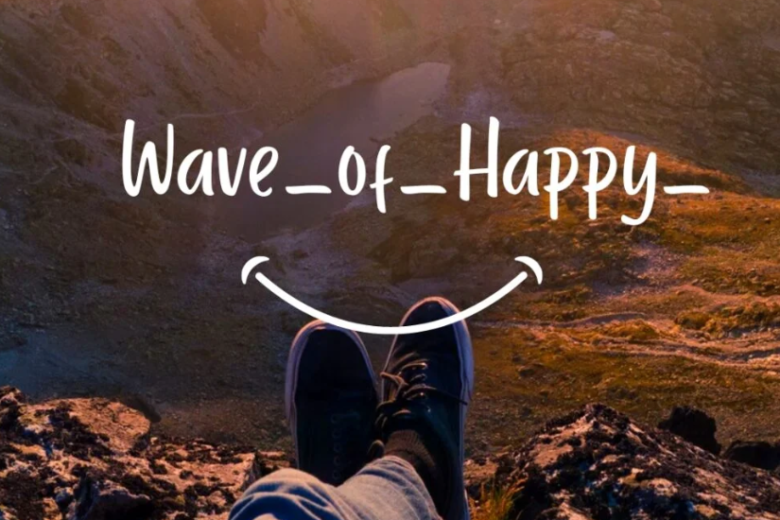As you browse your social media feed, a new and uplifting trend catches your attention—everywhere you look, people are radiating positivity. This wave of happiness, where smiles, high-fives, and random acts of kindness are passed from person to person, has become a viral sensation. But what makes this movement so compelling? In this article, we’ll explore its origins and analyze what the popularity of the “Wave of Happy” reveals about the current state of society. Far more than just a fleeting internet trend, this movement highlights our universal desire for human connection, offering a much-needed dose of optimism and reminding us of the best parts of humanity.
Tracing the Roots of the Wave of Happy
Birth of the Concept
The “Wave of Happy” first gained attention on social media in late 2020, a time when the world was navigating the challenges brought on by the COVID-19 pandemic. An anonymous Twitter user coined the term, giving voice to a collective desire for positivity and connection during a period of widespread isolation and uncertainty. What began as a simple hashtag, #WaveofHappy, quickly turned into a viral movement that transcended borders, offering a much-needed escape from the negativity that dominated the news cycle. As people faced extended periods of lockdown, financial instability, and health concerns, this uplifting trend provided a glimmer of hope. It became more than just a catchphrase; it was a symbol of resilience and the human capacity for joy in times of hardship.

The Power of Online Positivity
During the pandemic, social media became a crucial lifeline for maintaining connections, and it also emerged as a platform for spreading positivity. As isolation set in, people turned to digital spaces to share their experiences and feelings. Users flooded their feeds with feel-good messages, photos of rainbows, and videos of acts of kindness—whether it was virtual celebrations, messages of hope, or creative ways to stay connected while socially distanced. These posts were tagged with the #WaveofHappy, sparking a chain reaction as others joined in, amplifying the spread of positive content. The viral movement was a reminder of the power of optimism, providing a virtual hug to millions across the globe. It created a sense of community that bridged the gaps caused by physical separation, reinforcing the idea that happiness, no matter how small, could be contagious and spread far and wide.
An Organic Uprising
What made the “Wave of Happy” so powerful was its grassroots nature. The movement was not orchestrated by any single influencer, brand, or organization; instead, it grew organically through the efforts of countless individuals. Everyday social media users began to share their stories, uplifting images, and messages of hope, tagging their posts with #WaveofHappy, which created a ripple effect. The organic spread of this movement meant that it was highly inclusive, with no barriers to participation. Anyone with access to social media could contribute, regardless of their background or social status. The decentralized nature of the movement allowed it to be personalized, with each individual adding their unique touch to the wave. This sense of collective participation is what allowed the message to reach millions and resonate deeply with people from all walks of life. The simplicity of the movement, combined with the widespread appeal of shared joy, allowed it to grow quickly, becoming a global phenomenon that was both personal and universal at the same time.
Comfort in a Time of Crisis
Amid the global uncertainty and emotional strain of the pandemic, the “Wave of Happy” became a beacon of light for many. The videos, images, and messages shared under this movement provided comfort, reminding people that even in the most challenging times, small acts of kindness and joy could still be found. For those dealing with feelings of loneliness, stress, or anxiety, these posts served as a reminder that they were not alone. The movement acted as a virtual support system, offering a sense of solidarity and connection in a time when physical interaction was limited. The messages shared were often simple yet powerful, conveying hope and the possibility of brighter days ahead. Through these small but meaningful gestures, the Wave of Happy demonstrated how human connection and positivity could transcend physical distance, offering emotional relief to millions. It became a testament to the resilience of the human spirit and the profound impact that collective optimism can have, even in times of crisis. The simple act of sharing a positive message could uplift someone halfway across the world, making the “Wave of Happy” an enduring symbol of hope and unity during one of the most trying periods in modern history.
Decoding the Message Behind the Wave of Happy
A Call to Spread Joy
The song “Wave of Happy” is more than just a catchy tune—it’s an anthem for kindness and positivity, perfectly encapsulating the core message of the movement. With its uplifting lyrics like “make someone happy” and “pass it on,” the song acts as a powerful reminder that spreading joy doesn’t require grand gestures, just a willingness to share warmth and love with others. The phrase “wave of happy” symbolizes the ripple effect that kindness can create, spreading outward from one person to the next, gradually reaching entire communities and uplifting the spirits of countless individuals. As the song encourages people to actively seek opportunities to make others happy, it serves as a call to action to engage in simple, yet meaningful acts of kindness. Whether it’s a smile, a kind word, or a small gesture of support, the song reminds us that each positive action can have a lasting impact, and the more people who participate, the larger the wave of happiness becomes.
Simplicity and Catchiness
The song’s power lies in its simplicity. The lyrics, crafted with ease and repetition, are designed to resonate with listeners, sticking in their minds long after the music stops. Phrases like “make someone happy” are repeated throughout, ensuring that the message is clear and unforgettable. This straightforward approach makes the song accessible to people of all ages and backgrounds. Its catchy melody, paired with easy-to-remember lyrics, transforms it into more than just a song—it’s a chant for joy, one that can be sung and shared by anyone, anywhere. This simplicity makes the song an ideal tool for spreading the movement’s message of positivity and kindness, as it encourages people to join in, whether they’re humming the tune to themselves or singing along with friends. The ease with which the song is shared contributes to the spread of the Wave of Happy, as its familiarity helps people feel empowered to pass the message on, turning the act of sharing happiness into a communal experience.
A Message of Compassion
At the heart of the “Wave of Happy” song is a profound message of compassion. The lyrics serve as a gentle reminder that kindness isn’t about extravagant gifts or complex acts; rather, it’s about showing empathy and a genuine concern for others. The song underscores the idea that even small actions—whether it’s a friendly compliment, a moment of encouragement, or an unexpected act of generosity—can create a significant positive impact. It calls on people to look beyond their own struggles and to think about how they can make someone else’s day a little brighter. Compassion, as portrayed in the song, doesn’t depend on one’s financial status, skills, or resources. What it requires is the ability to connect with others emotionally and a desire to improve their well-being. This message is especially poignant in times of difficulty, reminding us that in moments of hardship, we still have the power to spread goodwill and make a difference. By focusing on compassion, the song highlights the goodness that exists in humanity, reinforcing the idea that kindness is something everyone can contribute to, no matter the circumstances. Through these simple but profound messages, the Wave of Happy serves as a beacon of light, urging people to nurture their innate capacity for kindness and to use it as a tool for creating a more compassionate world.
The Rapid Spread and Popularity of the Wave of Happy
Viral Success Across Social Media
The “Wave of Happy” spread like wildfire across social media platforms, demonstrating the immense power of online communities. The original video, featuring a synchronized dance at a music festival, gained more than 50 million views in its first week alone.
YouTube and Facebook
On YouTube, the video quickly amassed millions of views, with countless positive comments from people expressing their joy. Facebook also saw widespread sharing, with millions tagging their friends, encouraging them to watch the video and smile.
Twitter and Instagram
Short clips from the viral video flooded Twitter, where the hashtag #WaveofHappy became a trending topic. The video also spread rapidly on Instagram, where influencers and everyday users alike shared their own versions of the dance and positive messages, amplifying the movement.
The Power of Social Networks
The massive success of the “Wave of Happy” on social media shows how online platforms can spread positivity. Unlike many viral trends that are centered around humor or entertainment, this movement highlighted the ability for good to go viral, as millions connected through a shared experience of joy and human kindness.
The Dance Craze: The Wave of Happy Choreography
Origin and Creator
The viral dance routine that accompanies the Wave of Happy movement was created by British choreographer Shahar Bahar. Designed to be a simple, feel-good routine to Pharrell Williams’ hit song “Happy,” the dance quickly caught on, with people from all walks of life sharing their own performances.
Worldwide Adoption
The “Wave of Happy” dance became a global phenomenon, with participants from around the world recording their versions of the routine. Starting in the UK, the trend spread to Europe, the Middle East, Asia, Africa, and beyond, with everyone—from schools to businesses—joining in. The simplicity and joyfulness of the routine made it accessible to people of all ages and backgrounds.
A Legacy of Positivity

While the frenzy around the Wave of Happy dance eventually slowed, its impact remains. The dance continues to be performed at weddings, flash mobs, and celebrations, serving as a reminder of the universal desire for connection and shared joy. Through social media and the creative use of dance, the Wave of Happy showed how music and movement can unite people across the globe.
The Lasting Impact of the Wave of Happy
Social Media Frenzy
The “Wave of Happy” quickly became a viral sensation, as heartwarming videos began flooding social media platforms, capturing the attention of millions around the world. These videos showcased a wide variety of individuals, from celebrities to everyday people, all coming together to participate in the movement and spread joy. The hashtag #WaveofHappy gained massive traction, becoming synonymous with hope and unity during a time of global uncertainty. In these videos, people of all ages and from diverse backgrounds took part, from children dancing in their living rooms to patients in hospitals, whose spirits were lifted by the kindness of strangers. The simplicity and universality of the concept made it accessible to everyone, and soon it became not just a viral trend but a global celebration of positivity. The movement’s inclusiveness allowed it to transcend geographical, cultural, and social boundaries, creating a shared experience that united people in their collective need for joy and connection. This viral spread of uplifting content on social media gave individuals a tangible way to contribute to the greater good and helped counterbalance the overwhelming negativity that dominated the news cycle at the time.
Mainstream Media Coverage
As the #WaveofHappy gained momentum online, it captured the attention of mainstream media outlets, who recognized the power of this grassroots movement. Major news organizations like CNN, The TODAY Show, and BBC featured stories about the phenomenon, highlighting the emotional impact the movement had on people around the world. Journalists and reporters interviewed participants from all walks of life, including celebrities, everyday individuals, and even healthcare workers who found solace in the movement during challenging times. The media coverage helped amplify the message of the Wave of Happy, reaching even broader audiences and inspiring others to take part. Through these segments, viewers learned about the personal stories behind the videos and saw how small acts of kindness could have a profound ripple effect. The mainstream media’s involvement helped legitimize the movement, turning it from a viral trend into a cultural moment. It also provided a platform for people to share their personal experiences, demonstrating that the Wave of Happy wasn’t just a passing fad but a genuine movement rooted in empathy and solidarity.
A Legacy of Connection and Hope
Though the initial surge of the Wave of Happy may have been short-lived, its impact has endured far beyond its viral peak. The videos and messages of kindness continue to circulate, reminding people of the power of small, thoughtful gestures to create joy. More than just a fleeting social media trend, the movement left a lasting legacy of connection and hope. It served as a reminder that even in the darkest of times, there are ways to find light and make a difference. People who participated in the movement discovered new ways to connect with others, often across great distances, showing that the power of shared positivity can transcend physical boundaries. The Wave of Happy also reinforced the importance of community and solidarity, encouraging individuals to uplift one another in times of crisis. Its message continues to inspire new generations to look for opportunities to spread happiness and kindness, not just in moments of crisis but as a part of their everyday lives. Ultimately, the legacy of the Wave of Happy proves that, even in the most challenging circumstances, humans have the capacity to create meaningful connections and spread hope, leaving an indelible mark on the hearts of those who experienced its reach.
FAQs
Q: What is the “Wave of Happy”?
A: The “Wave of Happy” is a viral movement that emerged during the COVID-19 pandemic, spreading positivity and kindness across social media. It began as a simple hashtag, #WaveofHappy, and quickly turned into a global phenomenon. People shared feel-good messages, images, and videos, helping to combat the isolation and uncertainty many were experiencing.
Q: How did the “Wave of Happy” start?
A: The movement began in late 2020 when an anonymous Twitter user coined the term and started sharing messages of positivity. The hashtag quickly gained traction as people across the world embraced it, particularly in response to the difficult circumstances of the pandemic.
Q: What role did social media play in the “Wave of Happy”?
A: Social media played a crucial role in the viral spread of the “Wave of Happy.” Platforms like Twitter, Instagram, Facebook, and YouTube allowed people to share uplifting content, participate in the movement, and connect with others. The simplicity of the hashtag made it easy for anyone to join in, creating a sense of global community and shared joy.
Q: Was the “Wave of Happy” a one-time trend?
A: While the initial viral surge of the “Wave of Happy” was short-lived, the movement has left a lasting impact. Its message of kindness and positivity continues to inspire individuals and communities, demonstrating that small acts of joy can have a profound effect even in times of hardship.
Q: How did the “Wave of Happy” impact people?
A: The “Wave of Happy” provided emotional relief during the pandemic, offering a sense of connection and support when physical interaction was limited. For many, it became a reminder that happiness could be found even in the darkest of times, lifting spirits through simple acts of kindness and encouragement.
Conclusion
The “Wave of Happy” is a global movement that emerged during the COVID-19 pandemic in response to isolation and uncertainty. Starting with the hashtag #WaveofHappy, it quickly gained traction on social media as people shared uplifting messages, videos, and images to spread positivity. Fueled by everyday individuals, rather than influencers or brands, the movement became a symbol of resilience, compassion, and human connection, transcending physical distance. The viral dance choreographed by Shahar Bahar to Pharrell Williams’ “Happy” further amplified its reach. Though its peak has passed, the “Wave of Happy” remains a lasting reminder of the power of kindness and the enduring human spirit.
Read Next: how-many-bluegill-for-7400-gallons-of-water
